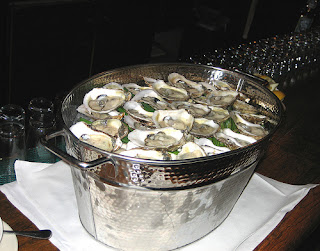by Justin Doyle, JRA's Outreach Manager
“The bottom of the James River is one enormous oyster-bed,”
wrote a New York Times reporter who
sailed with an oystering schooner in 1880. “From its mouth for 20 miles up, it
is nothing more or less than a natural oyster-bed. Go anywhere in it you may
and push to the bottom a pair of oyster-tongs, bring them together, and lift
them out of the water, and you will catch oysters.”
Native Eastern Oysters (Crassostrea virginica) were once
prevalent in the James River and Chesapeake Bay. According to the National
Oceanic and Atmospheric Administration Chesapeake Bay Office, oyster
populations in the Chesapeake Bay today are less than 1% of their historical
populations. The steep decline in population is attributed to poor water
quality, disease (MSX and Dermo), and over-harvesting. Poor water quality
stresses oysters making them more susceptible to disease.
Fortunately, oyster restoration efforts are underway
throughout the Chesapeake Bay Watershed. Virginia recently launched the largest
oyster replenishment effort in its history. Oyster shells mined beneath the
James River near Jamestown are being used to create habitat in areas of the
river where oysters have historically grown. According to Natural Resources
Secretary, Doug Domenech, "Oysters in Virginia are about an $8 million
business now, and in fact last year we harvested the most oysters since 1989.”
Not only are oysters economically important, they are
ecologically important to water quality. Oysters are filter feeders, which means
they filter their food from the water as they feed. It is believed historical
populations were able to filter the entire Chesapeake Bay in a week! It takes
the current population about a year to filter the entire bay.
SLURP! Have you
ever tried a flight of raw oysters? If you haven’t and you like oysters, you
should. The flavor of an oyster varies depending on where it is harvested.
Oysters harvested from Virginia rivers like the James and Rappahannock are less
salty than oysters harvested from Chincoteague Bay, located on Virginia’s
Eastern Shore. On a recent visit to Richmond’s Rappahannock restaurant, an outpost of Rappahannock River Oyster Co., I compared
the flavor of an oyster raised in the Rappahannock River to one raised in the
Chincoteague Bay. After slurping each oyster down my gullet, their unique
flavor profiles became evident. The Rappahannock had a mild almost buttery
flavor compared to the Olde Salt from Chincoteague Bay, which was briny. I
highly recommend the experience!
Sources:
“Oysters of the James” New
York Times article from the May 16, 1880: http://query.nytimes.com/mem/archive-free/pdf?res=9800E4D7173FEE3ABC4E52DFB366838B699FDE
“Oyster Shells on the Move” Public News Service article from the July 9, 2013: http://www.publicnewsservice.org/index.php?%2Fcontent%2Farticle%2F33377-1
Oyster Restoration – National Oceanic and Atmospheric Administration
Chesapeake Bay Office:
Oyster Reefs - National Oceanic and Atmospheric Administration Chesapeake
Bay Office


No comments:
Post a Comment